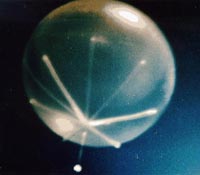|
|

|

|
The
long duration balloon in flight
shortly after launch. Click to enlarge.
|
|
|
|
|
The
Balloon Illusion
|

|
Believe
half of what you see.
by Paul Doherty
January
2, 2002
On
December 21, 2001 a long duration balloon was launched near
McMurdo station in Antarctica. A balloon launch is different
from a rocket launch. When the balloon is released it departs
in complete silence. After release, the balloon rises in slow
motion. Over four hours it rises to its final altitude of
120,000 feet or 24 miles (36 km) ascending an average of 500
feet per minute.( I have a hard time running uphill at 50
feet per minute.) Then it holds its altitude in the stratosphere
while winds blow it on a circular path around Antarctica.
|
|

|

|
A
view of a balloon fully inflated above 100,000 ft. Click
to enlarge.
|
|
|
|
The
higher the balloon rises, the lower the air pressure at its
elevation. The helium inside the balloon expands in the lower
pressure environment. The helium bubble inside the balloon
initially has a diameter of 150 feet (45m), when the balloon
reaches cruising altitude it is a sphere 900 feet (270m) in
diameter.
The
volume of the balloon doubles after it rises to 18,000 feet
(5500m) then doubles again by 35,000 feet(11,000m). Above
35,000 feet the volume doubles every 15,000 feet (4,500 m).
By the time the balloon reaches 120,000 feet it has doubled
its volume 8 times, so its volume is 2^8 or 256 times larger.
As the balloon rises through the lowest layer of the atmosphere,
the troposphere, the temperature decreases below -40 C. However,
when the balloon enters the stratosphere the temperature remains
approximately constant.
A
Size-Distance Illusion
|
|

|

|
To
the naked eye, the balloon at altitude looks slightly
smaller than the full moon. Click to enlarge.
|
|
|
|
I watched the balloon rise more and more slowly and then stop
rising. This was an illusion. The balloon was still rising,
and yet it appeared to stop. If the balloon were a constant
size object it would get smaller and smaller as it moved away
from me. However, the balloon was growing in diameter as it
rose. If I see an object growing in size and there are no
other clues to its distance, I assume it is moving toward
me. At one altitude near 75,000 feet (23,000 m)as the balloon
rises, it grows in volume at just the right rate to keep its
apparent size constant. Even though it is moving away from
me the balloon image stays the same size on my retina and
I "see" it standing still. As the balloon rises
at first it looks like it is getting smaller then above 75,000
feet it gets larger again.
At
120,000 feet the 900 foot diameter balloon has an angular
diameter of 0.4 degrees. Its diameter is 80% the size of the
sun or the full moon. Many pilots have seen these balloons
and reported that they needed to change their flight path
to avoid colliding with the balloon. Even though the balloon
was over 20 miles higher than they were. There were no clues
about the size of the balloon so they had no idea how far
away it was.
Balloons
as UFOs
The
balloon is so far away that if you drive along the ground
it stays in the same position relative to you. (Note that
as you drive nearby trees rapidly move backwards, but distant
mountains seem to stay in the same place.) To many people
the balloon in the sky appears to follow them. When these
high altitude balloons are launched over populated areas many
UFO reports are made.
|

